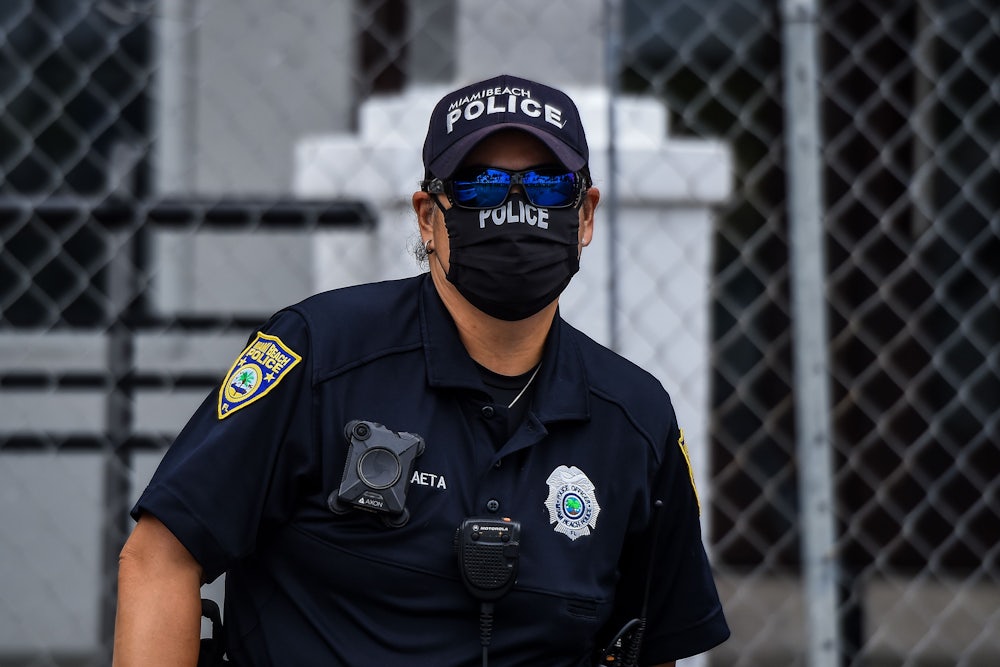The pandemic has slowed much American police work, but police are still working. “As of May 17, 375 people had been shot and killed by on-duty police officers in 2020—about the same rate as other recent years despite the coronavirus pandemic,” Wesley Lowery, who helped track killings at The Washington Post, observed on Tuesday. Just a day before, a 46-year-old black man named George Floyd was killed by a white Minneapolis police officer who pinned him to the ground, kneeling on his neck for five minutes. Floyd’s last words were captured in a video on Facebook: “Don’t kill me” and “I cannot breathe.” Minneapolis Mayor Jacob Frey swiftly fired the four officers involved and has called for criminal charges.
For all of the promises made post-Ferguson, after (now former) Officer Darren Wilson shot and killed Michael Brown nearly six years ago, police continue to kill at an undisturbed pace. Each year, police on duty claim the lives of between 900 and 1,100 people, according to the Police Integrity Research Group at Bowling Green State, with fewer than eight, on average, resulting in indictments and even fewer convictions. “The only Minneapolis police officer to be convicted in an on-duty, fatal shooting was Mohamed Noor, who shot and killed Justine Ruszczyk in 2017,” reports Minnesota Public Radio. “Noor is black. Ruszczyk was white.”
While police kill, their unions rally to their defense. Before Mayor Frey fired the officers involved in Floyd’s death, the Minneapolis Police Federation, the local police union, had openly defied him over his barring officers from attending “warrior” trainings, which encourage officers to regard their job as if they were engaged in military combat. One representative course is called “On Killing.” These are less a training than an immersion in an alternate reality, in which, as Craig Atkinson, director of the police militarization documentary Do Not Resist, described it, “every single traffic stop could be, might be, the last stop you ever make in your life.”
Mayors like Frey, as well as city councils, at least on paper have power over the police. But even when oversight is exercised, police continue to kill and keep their jobs. Now some cities are being urged to take a broader view: to shrink the police force altogether through the power of the budget, particularly at a moment when so many other social programs and essential services are at risk of being cut during a pandemic.
In the summer of 2019, New York Police Department (NYPD) Commissioner James O’Neill fired the officer who killed Eric Garner—who died while being crushed by police attempting to arrest him, while he repeated, “I can’t breathe.” In response to the officer’s termination, police threatened a slowdown in protest, as they did five years earlier, after Garner’s death, when protesters took to the streets. Arrests and summons dropped, and so, too, did reports of major crimes. Less policing made the city no less safe. Without meaning to, police provided a case study for police reform advocates.
The coronavirus pandemic has also led to such a drop in policing and in crimes—one reason why the Policing & Social Justice Project has called for the city to cut the current $5.6 billion NYPD budget by $1 billion over four years. Police overtime accounted for $728 million in 2019, wrote the project’s coordinator, Alex Vitale, in the New York Daily News, while “New York City spends more on policing than it does on the Departments of Health, Homeless Services, Housing Preservation and Development, and Youth and Community Development combined.” The pandemic only helps make the case that money spent on police work that does not keep the city safe is far better spent on protecting New Yorkers by improving health care and housing.
It’s not an unprecedented restructuring of city priorities: For the last few years, activists in Austin, Texas, including groups like the Austin Justice Coalition (AJC), have pressed the city to cut police budgets and reduce the number of police. They pushed for the city council to vote down the police association’s contract, launching their campaign during the budget session, wrote Sukyi McMahon and Chas Moore of AJC, “so that our demands would interrupt the flow of money into the department.” The contract the council later passed “priced out at $44 million, half of the [police] association’s $82.5 million bid.” They continue to push the city council, advocating that it assign emergency medical services to respond to mental health calls instead of the police and reallocate $1.75 million from the police budget to emergency services—which would also cut 30 police officers.
In Durham, North Carolina, activists successfully campaigned through the city budget process and won “zero police expansion,” as the coalition Durham Beyond Policing described it. “We crafted a strong proposal for why we need Durham to invest in life-affirming services, not an unjustified expansion of the police force,” its spokeswoman Manju Rajendran told Indy Week. The group’s proposal begins by asking, “What does public safety look like?” This is the shift needed in debates over police killings. In delegating “safety” to cops, what communities really want and need gets left out. Durham Mayor Pro Tempore Jillian Johnson has echoed their points, writing of the decision not to fund new police officers, “The safest communities don’t have the most cops; they have the most resources.”
